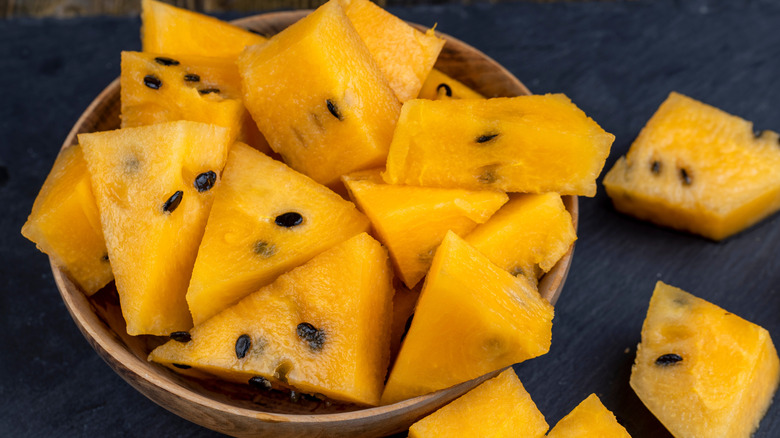The Big Flavor Difference Between Red And Orange Watermelon
A slice of sweet and juicy watermelon is a cool, refreshing treat, and the water it's packed with helps keep you hydrated on a hot summer day. We also eat with our eyes, and watermelon's bright red color, set off by the white and green rind, looks almost as good as it tastes. But people may be surprised to learn that watermelon can be orange too, or have yellow or even white flesh. The flavor of an orange-hued watermelon is a little different from the classic red variety. While still tasting like watermelon, it has other flavor notes that make it special.
Orange watermelons have a more honeyed sweetness, often with a subtle flavor of tropical fruits like mango, pineapple, or papaya, cantaloupe, or pear. Their taste is also described as smoother and less acidic than red watermelon, which contains more citric and malic acids. There are different varieties of orange watermelon, and although they tend to be sweeter than their red counterparts, it varies among them. Orangeglo, which is one of the more popular orange varieties in the United States, is very sweet with tropical notes, while the Tendersweet Orange has a lighter flavor and mild honey taste. The Orange Crisp is a sweeter melon, and as its name suggests, has a crisp texture.
Yellow watermelons also have a difference in flavor from pink and red ones, with a similar flavor profile as orange watermelon. Both orange and yellow types are missing the lycopene that makes watermelon red, while the orange ones are high in beta-carotene, the same substance that gives carrots their color.
Orange watermelons' origins and how to eat them
While you might think orange and yellow watermelons were created by modifying red ones, the history is actually the opposite. Watermelon's bitter, green-white ancestor grew wild in Africa. The ancient Egyptians began cultivating it some 5,000 years ago, and with selective breeding in Egypt and beyond as the watermelon spread, it had become yellow or yellow-orange by the 5th century. It continued to be bred for greater sweetness, and because the genes for sugar content and red color are paired, the melons became redder as they got sweeter.
If you didn't know a watermelon was orange, you wouldn't be able to tell from its outside, which looks like a normal watermelon. They can be oblong or round, range from 10 to 30 pounds, and have a light green rind with dark green stripes. Like red watermelon, they can be seedless or have seeds.
An orange watermelon can be treated just like a regular one, so grill it for an impressive cookout side, or freeze and grate it to make delicious shaved ice. But you can also take advantage of those subtle tropical flavors. Make a fruit salad or smoothie with orange watermelon and mango, pineapple, papaya, or cantaloupe, the fruits whose flavors it evokes. Pair it with one of them or another tropical fruit in a spicy salsa with jalapeños and onions. Mentally transport yourself to a Caribbean beach by sipping an umbrella cocktail made even more tropical with fresh orange watermelon juice.

